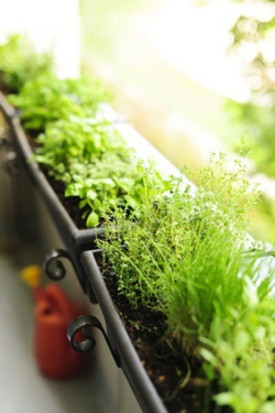There they are again. Those tall, colorful racks of Burpee seeds that emerge in the spring taunting me with the prospect of a fresh, homegrown bounty of herbs – all for just a few bucks. While I can remember these tantalizing little packets from the time that I could walk, even as an adult I’ve never risen to the challenge – opting always for the ready-made bunch of herbs two feet away for half the price. This year, armed with a blinding, south-facing kitchen window and the desireFrom Seed or Not F to defy the general consensus that starting from seeds is impractical, I’ve decided to give it a go. I can return with the results in a few months, but for now I will share what I’ve learned about getting started.
I found PlanetNatural.com to be the most useful site on the web in helping helpless beginners. The Herb Society of America is a wonderful, scholarly site and an excellent source for those really looking to understand herbs and their uses, but PlanetNatural offers more information on different types of soils – and everything needed can be purchased right there. What I deduced, however, from all of the various sites and books I reviewed, is that if you are really serious about growing healthy and bountiful herbs indoors, it needs to be taken somewhat seriously. Poking a few seeds down in whatever potting soil you may have around and crossing your fingers may work if you get lucky, but your chances of success increase exponentially if precise conditions are met.
Aside from ensuring that your herbs will be in a well-lit window (a south or southwest-facing window that gets at least 4 hours of strong sunlight per day), the first step in ensuring the highest level of success when growing herbs from seeds, are the seeds themselves. Burpee is always a safe bet and they now have an entire line of organics for those looking to grow from seeds free of pesticides and fungicides. The problem with off or unknown brands is that the origin is often unknown and they can be too old to yield healthy plants. But, there are some wonderful seeds grown in the U.K. and other places abroad, so if you are straying away from Burpee, be sure to do some research or ask your local nursery pro.
When growing any plants indoors, the proper container is essential – but when starting from seeds, almost anything that is at least 3-4 inches deep that has drainage holes will do. The plastic flats used at nurseries are a perfect solution, but an egg carton will work just fine.
According to many experts, growing medium is better than potting soil for growing herbs in containers. Growing medium is, generally, a mixture comprised of all of the elements needed to grow plants, without the use of topsoil. Popular ingredients include vermiculite (a mica-like mineral), perlite (a volcanic glass with a high water content) and peat (a soil-like substance consisting mostly of decomposed vegetable matter). There are plenty of pre-made mixtures on the market, but if you really want to do it right, do some research or ask a local pro which herbs grow best in which blends. If you prefer not to get into complicated non-soil mixtures, good potting soil mixed with peat moss will work.
When it’s time to sow your seeds, a good rule of thumb is to plant 2-3 seeds per container. Set medium and large seeds at least one inch apart, and smaller seeds at 1/2″ apart. One mistake that many new gardeners make is pushing the seeds too far into the potting soil or growing medium. They only need to be covered to a depth of 3 times their size and it is best to sprinkle them on top and cover with a light dusting. Some seeds require direct sunlight to germinate, so be sure to check the instructions on your packet. And, don’t forget to label your herbs (popsicle sticks work well) so that you know which is which as they begin to grow.
Now that the seeds are sown, let the waiting game begin! It is important to keep the growing medium moist at all times and if you live in a very dry climate, it may even be necessary to tent the seedlings in plastic for a few hours per day. Tenting allows light moisture to be maintained without the worry of over-watering.
Herbs vary in the length of time between sowing and harvesting, but very generally speaking, seedlings should begin to sprout in about a week and can be transplanted into larger containers at about 3-4 weeks (when they reach appx. 3″ in height). Once they are in larger containers where there roots can really spread, they will begin to grow quickly and many (like basil) can be ready for harvest in just 8 weeks.
Happy sowing and growing!
Credit: Diana Cammarota




























